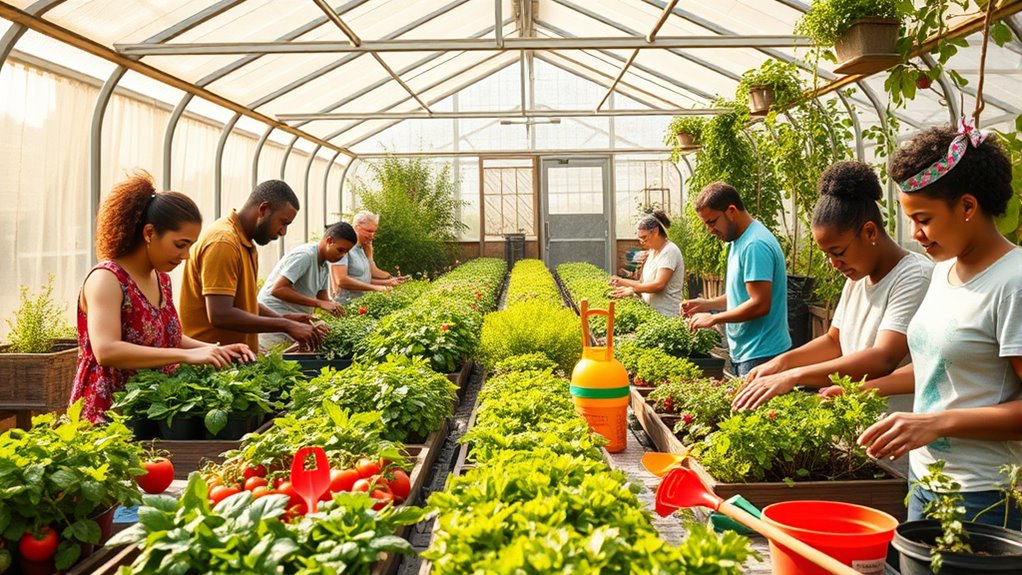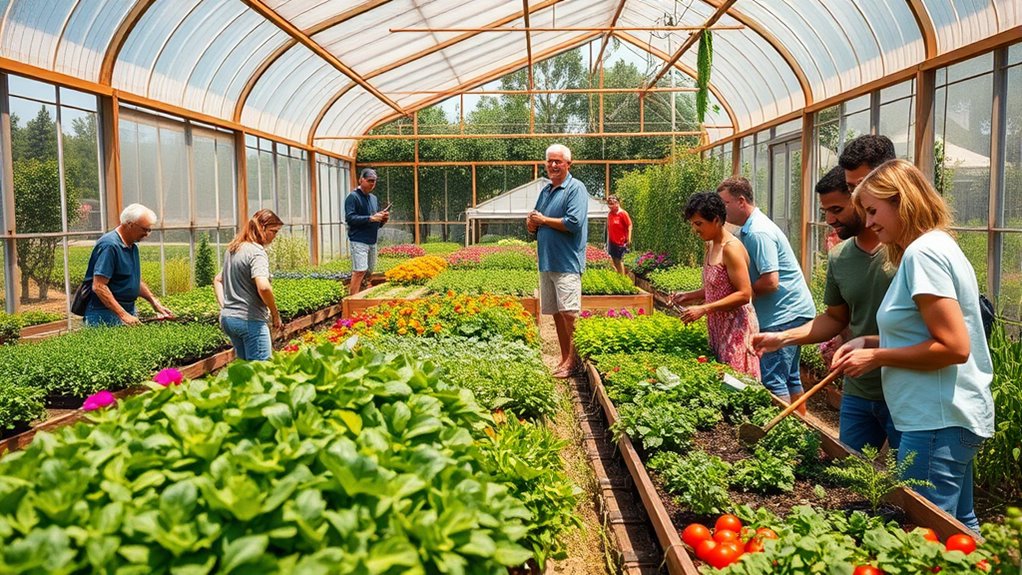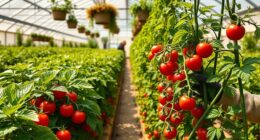Community greenhouses bring neighbors together to grow fresh, sustainable produce all year round. They support local food security, promote eco-friendly practices like water conservation and composting, and create opportunities for shared learning and collaboration. Working side by side, you can strengthen bonds and make a difference in your neighborhood’s environment. If you want to discover how these green spaces inspire sustainability and community spirit, keep exploring what they have to offer.
Key Takeaways
- Community greenhouses foster neighbor collaboration by providing shared spaces for sustainable gardening and learning.
- They enable year-round cultivation, enhancing local food security regardless of weather conditions.
- Volunteers participate in eco-friendly practices like composting, water conservation, and pest management.
- Educational programs promote sustainable agriculture, environmental awareness, and inclusivity among diverse community members.
- These initiatives strengthen neighborhood bonds and support resilient, eco-conscious local food systems.

Have you ever wondered how communities can grow fresh produce year-round regardless of the weather? The answer often lies in community greenhouses—collaborative spaces where neighbors come together to cultivate plants in controlled environments. These greenhouses are more than just garden spaces; they’re hubs of sustainable practices that minimize environmental impact while maximizing food production. By using efficient watering systems, composting organic waste, and selecting native or drought-tolerant plants, communities guarantee that their greenhouses remain eco-friendly and resilient. You can be part of this movement by volunteering your time and skills, helping to maintain these sustainable practices and guaranteeing the greenhouse’s success. Volunteer programs often involve tasks like planting, harvesting, or managing pests naturally, which reduces reliance on harmful chemicals and promotes healthier produce for everyone involved.
Participating in a community greenhouse through volunteer programs not only supports sustainable practices but also strengthens community bonds. When you join such programs, you’re directly contributing to local food security and environmental stewardship. It’s a hands-on way to learn about sustainable gardening techniques, from composting and rainwater harvesting to crop rotation and soil health management. These practices are essential for maintaining the long-term productivity of the greenhouse without depleting resources or harming the ecosystem. Additionally, understanding active listening and empathy can greatly enhance communication and collaboration among volunteers, making the experience more effective and enjoyable. Plus, volunteer programs often foster a sense of shared purpose and collective achievement, making the effort more meaningful and enjoyable.
Volunteering in community greenhouses boosts local food security and fosters teamwork.
Greenhouses also serve as educational platforms where neighbors of all ages can learn about sustainable agriculture. By participating in workshops or simply working side-by-side with others, you gain knowledge about growing food responsibly and reducing waste. This shared learning experience encourages a culture of sustainability that can extend beyond the greenhouse into everyday life. Moreover, these spaces often operate with a focus on inclusivity, welcoming volunteers of different backgrounds and skill levels, which fosters community cohesion. Effective communication within these groups can help ensure everyone’s ideas and concerns are heard, leading to more innovative solutions and stronger teamwork. Incorporating sustainable practices into daily routines can further amplify the positive impact of community greenhouses and inspire broader environmental awareness. Engaging in community involvement can also strengthen ties among neighbors, creating a more resilient and connected community fabric. Building awareness of environmental impact helps volunteers understand the importance of eco-friendly techniques that protect local ecosystems and promote biodiversity.
In essence, community greenhouses are powerful tools for fostering sustainable practices while building stronger neighborhoods. When you get involved through volunteer programs, you’re helping to create a resilient food system that works in harmony with the environment. Whether it’s tending plants, composting, or organizing educational events, your participation helps guarantee that fresh produce remains accessible all year long. As more communities embrace these greenhouses, they become crucial spaces where neighbors grow together—literally and figuratively—creating a healthier, more connected future.
Frequently Asked Questions
How Are Community Greenhouse Projects Funded?
Funding community greenhouse projects often comes from grant funding, which provides essential financial support for setup and operations. You might also find volunteer training programs that help mobilize community members to maintain the greenhouse, reducing costs. Local governments, nonprofits, and grants often collaborate to supply these resources. Your involvement in applying for grants or volunteering for training can directly impact the project’s success, making green spaces more accessible and sustainable in your community.
What Are the Safety Protocols for Volunteers?
Did you know that over 80% of greenhouse accidents happen due to lack of proper safety measures? As a volunteer, your safety is a priority. You’ll receive thorough greenhouse training that covers essential safety protocols, including proper tool use, handling chemicals, and emergency procedures. Always wear protective gear, stay alert, and follow instructions carefully. These safety measures help ensure a safe, enjoyable experience while contributing to the community’s green space.
Can Children Participate in Greenhouse Activities?
Children can absolutely participate in greenhouse activities, especially through children gardening and youth volunteering programs. You should guarantee activities are age-appropriate and supervised by an adult, fostering a safe environment. Encourage kids to learn about planting and caring for plants, making it fun and educational. With proper guidance, kids can develop a love for gardening while helping out, creating a positive experience for everyone involved.
How Is Produce Distributed Among Community Members?
The way produce is shared among community members is truly a miracle, turning neighbors into a unified family. You’ll find various distribution methods, like shared harvest days, donation boxes, or organized swaps. These methods promote fairness and guarantee everyone benefits from the greenhouse’s bounty. By participating in produce sharing, you help strengthen community bonds and make sure no one goes hungry, transforming abundance into collective well-being.
Are There Any Membership or Participation Fees?
You might wonder if there are membership costs or participation fees involved. Typically, community greenhouses keep these costs low or free to encourage participation and foster community spirit. Some programs may have small participation fees to cover supplies or maintenance, but many offer free memberships. It’s best to check with your local greenhouse to see their specific policies, ensuring you understand any costs before joining.
Conclusion
Community greenhouses bring neighbors together, fostering collaboration and shared success. By working side by side, you learn from each other and build stronger bonds that go beyond just plants. Isn’t it amazing how growing food can also grow trust and friendship? When you tend to these green spaces, you’re not just cultivating crops—you’re nurturing a vibrant, connected community. So, why not join in and see how much more you can grow together?









